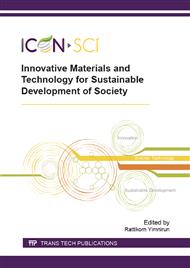[1]
K. Van de Velde, P. Kiekens, Biopolymers: overview of several properties and consequences on their applications, Polym Test. 21 (2002) 433–442.
DOI: 10.1016/s0142-9418(01)00107-6
Google Scholar
[2]
M. A. Woodruff, D. W. Hutmacher, The return of a forgotten polymer-polycaprolactone in the 21st century, Prog Polym Sci. 35 (10) 1217-1256.
DOI: 10.1016/j.progpolymsci.2010.04.002
Google Scholar
[3]
V. Jankauskaite, A. Laukaitiene, K. V. Mickus, Shape memory properties of poly(ε-caprolactone) based thermoplastic polyurethane secondary blends, Mater Sci. 15 (2009) 142-147.
Google Scholar
[4]
S.A. Theron, E. Zussman, A.L. Yarin, Experimental investigation of the governing parameters in the electrospinning of polymer solution, Polymer. 45 (2004) 2017-(2030).
DOI: 10.1016/j.polymer.2004.01.024
Google Scholar
[5]
Ji-Huan He, Yue Wu, Wei-Wei Zuo, Critical length of straight jet in electrospinning, Polymer. 46 (2005) 12637–12640.
DOI: 10.1016/j.polymer.2005.10.130
Google Scholar
[6]
Travis J. Sill, Horst A. von Recum, Electrospinning: Applications in drug delivery and tissue engineering, Biomaterials. 29 (2008) 1989-(2006).
DOI: 10.1016/j.biomaterials.2008.01.011
Google Scholar
[7]
NS Jagtap, SS Khadabadi, DS Ghorpade, NB Banarase, SS Naphade, Antimicrobial and antifungal activity of Centella asiatica (L. )Urban Umbeliferae, J. Pharm. and Tech. 2(2) (2009) 328-330.
Google Scholar
[8]
O.A. Oyedeji1 and A.J. Afolayan, Chemical composition and antibacterial activity of the essential oil of Centella asiatica growing in South Africa, Pharm Biol. 43 (2005) 249–252.
DOI: 10.1080/13880200590928843
Google Scholar
[9]
H.S. Vasavi, A.B. Arun, P.D. Rekha, Anti-quorum sensing activity of flavonoid-rich fraction from Centella asiatica L. against Pseudomonas aeruginosa PAO1, J microbiol immunol (2014) 1-8.
DOI: 10.1016/j.jmii.2014.03.012
Google Scholar
[10]
J. Han, Christopher J. Branford-White, Li-Min Zhu, Preparation of poly(e-caprolactone) /poly(trimethylene carbonate) blend nanofibers by electrospinning, Carbohyd Polym. 79 (2010) 214–218.
DOI: 10.1016/j.carbpol.2009.07.052
Google Scholar
[11]
Laleh Ghasemi-Mobarakeh, Molamma P. Prabhakaran, M. Morshed, M. Hossein N. Esfahani and S. Ramakrishna, Bio-functionalized PCL nanofibrous scaffolds for nerve tissue engineering, Mater Sci Eng. C 30 (2010) 1129-1136.
DOI: 10.1016/j.msec.2010.06.004
Google Scholar
[12]
R. K. Das, B. B. Borthakur, U. Bora, Green synthesis of gold nanoparticles using ethanolic leaf extract of Centella asiatica, Mater Let. 64 (2010) 1445–1447.
DOI: 10.1016/j.matlet.2010.03.051
Google Scholar
[13]
E.P.S. Tan, S.Y. Ng, C.T. Lim, Tensile testing of a single ultrafine polymeric fiber, Biomaterials. 26(13) (2005) 1453–1456.
DOI: 10.1016/j.biomaterials.2004.05.021
Google Scholar
[14]
Matthew R. Williamson, Allan G.A. Coombes, Gravity spinning of polycaprolactone fibres for applications in tissue engineering, Biomaterials. 25(3) (2004) 459–465.
DOI: 10.1016/s0142-9612(03)00536-2
Google Scholar


